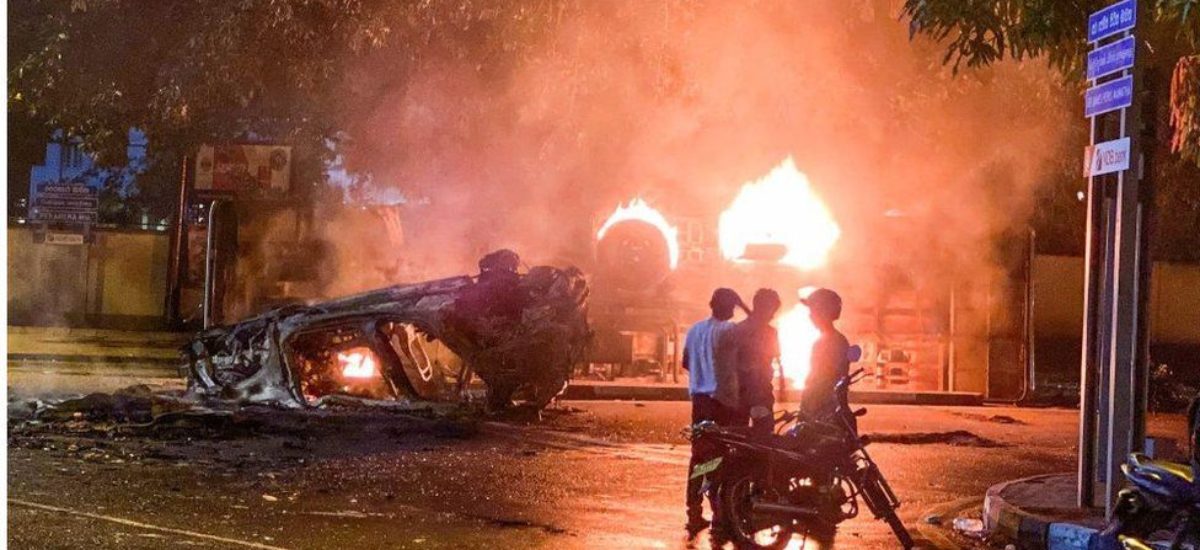Photo courtesy of BBC
Until Monday afternoon, the protests at Galle Face Green were overwhelmingly peaceful. Even when demonstrators stormed into the outer precincts of the Presidential Secretariat, it was to engage in symbolic resistance epitomised most unforgettably by Charitha Attalage’s holographic renditions. At first targeting the removal of President Gotabaya Rajapaksa and his family, the Gotagogama movement engaged with other issues including the question of what is to be done if, and after, the first family leaves.
The Galle Face protests did not betray, as some of its critics were wont to say, a lack of understanding of the political situation. Yet it was a sequel to an array of other protests that have been unfolding across the country over the last two years. Led by farmers, estate workers and garment workers, these demonstrations from below have been targeting the class divisions and inequalities that the COVID-19 pandemic unearthed.
Most of them have been targeting the government, in particular, its ill-advised overnight shift from chemical to organic fertiliser. That not a few of these people hiked all the way from one village after another in support of the Galle Face Movement tells us a lot about how a whole gamut of issues have brought protesters together. One poor farmer, travelling from Rikillagaskanda, hitched a ride with us on a trishaw. His story was the same as every other farmer’s; he had lost everything to the government’s fertiliser turnarounds and felt he had nothing to lose by visiting Galle Face. He had come to display his solidarity with the young, he said, and was fuming with anger against the Rajapaksas.
A resistance movement like this is hard to organise and harder to sustain. Its growth has been organic and phenomenal, not to mention unstoppable. Much of the reason for that has been an upsurge of middle class sentiment against the Rajapaksas. In 2019, Gotabaya Rajapaksa came to power on the support of a suburban middle bourgeoisie, drawn partly from the public sector and sections of the working class mobilised by SLPP-allied trade unions. Opposing the government of the day, even farmers cast their vote in favour of him and his party. A youthful electorate, angry at establishment politics after the Easter Attacks and optimistic about a non-political maverick in power, followed suit.
From a political science perspective, this was a tough balancing act to maintain. The paradox of the Gotabaya Rajapaksa presidency was that while it incorporated several class elements, its entrenchment of familial dynastic rule prevented him from engaging in or bringing about such a balancing act. The lower classes were the first to go; hemmed in by a pandemic, they turned the other way. SLPP trade unions lost grassroots support, while factory workers and estate workers began mobilising against the regime. Then, in the face of import restrictions, the middle classes began to make noises. When fuel shortages and power cuts – an unholy combination for a group so dependent on transport and electricity – hit the country, and the rupee was floated, the Rajapaksa government lost another crucial electorate.
That the demonstrations which began in Mirihana and culminated in Galle Face have been overwhelmingly peaceful despite all this should tell us everything we need to know about what happened on Monday. The problems started when, on Sunday, it was announced that Mahinda Rajapaksa had tendered his resignation to the president. But that same day he had travelled to Anuradhapura, meeting supporters who told him that while people wanted his brother to go, and that his brother should go, he should not leave. The then Prime Minister endorsed these sentiments by hinting that, whatever the faults of the government were, he was not responsible for them. This was Act One of the drama that followed.
Act Two began when SLPP MPs and local government officials close to Rajapaksa, including Kurunegala MP Johnston Fernando and Moratuwa Mayor Saman Lal, organised busloads of pro-Rajapaksa crowds to pay Mahinda a visit at Temple Trees in the hopes of convincing him to stay. We don’t know what exactly happened next but what we do know is that after Mahinda delivered a terribly ambivalent speech that could be interpreted either way (“I am ready to make any sacrifice for the country’s sake”), pro-Rajapaksa crowds began chanting against outside protesters and attacking them, moving from Mainagogama to Gotagogama and vandalising everything. This was Act Three.
Urban protests in Sri Lanka tend to be leaderless but they remain resolutely peaceful. Act Three was the tipping point that turned them loose and sour at Gotagogama. Infuriated by the attackers and by police inaction – particularly when the police and the military had been more than a little hostile against them in the last few weeks – the Gotagogama protesters began to retaliate. Social media was awash with videos of several pro-Rajapaksa vandalisers being disposed of; from throwing them into rubbish heaps to pushing them into the Beira Lake, the anti-Rajapaksa crowd despatched them all. Publicly humiliated, many of them stripped naked, by the end of the day most of them had been hounded and chastised.
What happened next has left protesters divided and confused. Almost simultaneously, both protesters and other urban elements fought back against the pro-Mahinda crowd. Their tactics did not really accord with the non-violent veneer of the Gotagogama crowd. At the Beira, for instance, we were witness to a crowd of mobs frenziedly throwing vehicles and pushing pro-Mahinda elements into the lake. Some of the latter were beaten up and all of them were debarred from coming ashore. They clung on to makeshift boats and did what they could to stay above water but newly arrived mobs used the safari boats at the Beira to attack them whenever they got too near the bank.
Meanwhile outside Colombo, anti-Rajapaksa mobs began dishing out violence to those suspected of pro-Rajapaksa sympathies. They first targeted buses carrying the pro-Mahinda supporters. Bulldozing the buses, they threw stones at the protesters, got the latter out and publicly chastised them. Mobs being mobs, the anti-Rajapaksa elements, drawn from totally different social groups from those that made up Gotagogama, went in search of other fellow travellers, setting their houses on fire and vandalising their property. It hardly needs to be said that none of this accorded with the Gandhian, nonviolent stature of the Gotagogama crowd, even if many among that crowd initially supported the violence.
By nightfall most of those who had protested against the Rajapaksas at Gotagogama and elsewhere felt that things were going out of hand. This was when some of the protesters began questioning whether the acts of arson were all part of a long drama, scripted by the government itself, perhaps as a prelude to or justification of a military takeover. While such theories can’t be verified outright, they can’t be dismissed either. In any case by dawn the fires had burnt away, the scarred remains of the houses, hotels and office complexes of the ruling political class bearing testament to the anger of the people. This was all a long time coming; that it happened because of Mahinda Rajapaksa’s fumbling over his resignation is a damning indictment on the government, the cabinet and the president.
Needless to say, what happened has divided opinion. On the one hand, those who initially supported vigilante, mob-led violence have turned around, not just condemning the attacks but also conjecturing whether some higher hand was involved in them. On the other hand, some of those who committed themselves to Gotagogama have condoned these acts, many of them admitting that violence can only be met with violence. While this opens up an entire debate about the ethics of violence, especially in relation to a leaderless protest like #GotaGoHome and #RajapaksasGoHome, it is true that it has been a rude awakening for the SLPP including MPs not yet besmirched with allegations of corruption.
Where do we go from here? Several professional associations, including the Bar Association, have proposed possible courses of action. The main opposition, the SJB, has agreed in principle to an interim administration, although one without President Gotabaya Rajapaksa and “crisis instigators.” The latter term is interesting; it suggests that the SJB is not totally opposed to cohabiting with parties and MPs and officials from the SLPP, provided they come out clean. The removal of the Rajapaksas is a sine qua non of any arrangement, for sure but then as the past few days have made it clear, even the SLPP seems wary of the first family. In any case, if Sri Lanka is to avoid turning into a Libya, it must get the Rajapaksas out.
Sri Lanka is a nation capable of intense violence, even against its own people. Yet it is also a nation capable of healing and reconciliation. The problem with this country isn’t that it is devoid of options but that it’s let go of too many opportunities. Blaming all that on political elites is clearly not the solution. But then a large part of the solution lies in reforming those elites, in changing the structures that sustain them. Violence is not the way to go about it. Yet there comes a point where, for a great many people, there seems to be no other answer or solution. This is why what happened and it mustn’t be allowed to happen again even if history, with all its twists and turns, has a tendency to repeat itself.
View this post on Instagram


